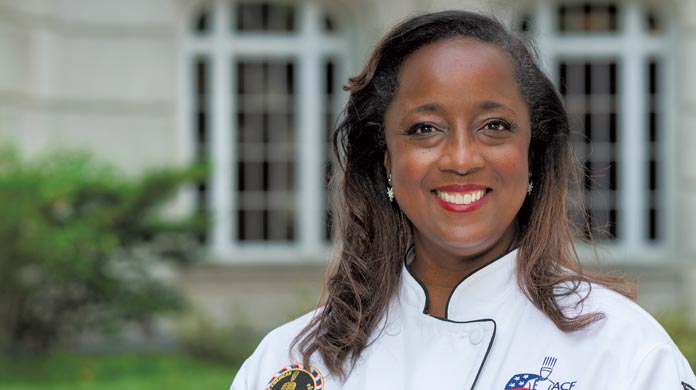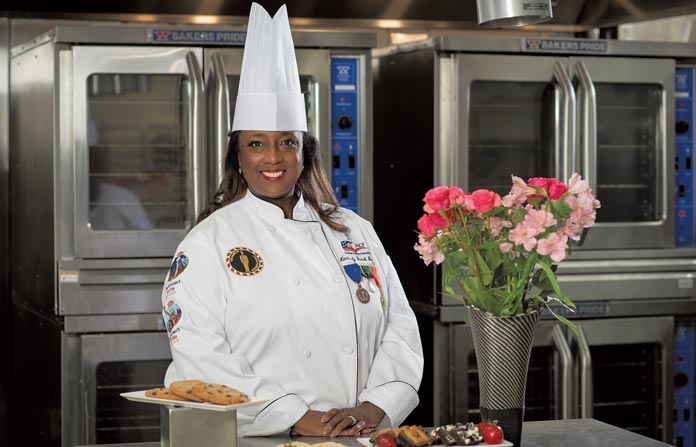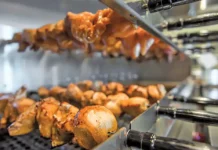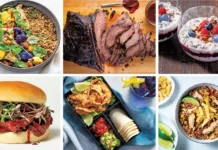
Celebrity Chef and President, American Culinary Federation
As the country recovers and restaurants shake the restrictions of COVID-19, chefs today face an ever-shifting set of problems. In order to survive, kitchens have had to become more creative and adaptable than ever.
To see what chefs are really up against, Total Food Service has sought out the insight of Kimberly Brock Brown, the recently-elected president of the American Culinary Federation (ACF). The ACF is now the largest professional chefs’ organization in North America with over 14,000 members in 170 chapters across the U.S. offering educational resources, training, apprenticeship, competitions, and accreditation. The ACF is also home to the ACF Culinary Team USA, representing the country in international, culinary competitions.
As the first person of color, first woman, and first pastry chef to be elected President of the ACF, in the organizations 91 years of existence, Kimberly Brock Brown looks to bring about meaningful change in her two-year tenure. Brown takes us inside the ACF to reveal the unique challenges chefs today face as well as her hopes for the ACF’s future growth and direction.
As the National President of the American Culinary Federation, please share how you first got interested in cooking with our readers.
Growing up in Chicago with two parents who loved to cook, I was always around good food. We were always cooking in my house, always in the kitchen, and I just fell in love with it and knew that’s what I wanted to do with my life.
When I was 19, I got a job waiting tables and every now and then the cook wouldn’t be there for breakfast, so I would get in the kitchen and experiment, just try to figure stuff out and feed the customers, but I really liked it.
From there I got an apprenticeship working at the Hyatt Regency in downtown Dallas, TX, and I was loving it— I was like a sponge. I learned all kinds of skills from a staff of professionals and it was a really great environment. I had a great mentor who taught me how to make pastries and that’s what I’ve been doing ever since!
What made you decide to run for President of the ACF?
I’ve been a member of the ACF since 1981, but never at ACF have I seen what I wanted to see. I’ve never seen as many women and people of color in leadership positions as I think there should be.
I remember one convention dinner sitting there and thinking that the awards just kept seeming to pass along to the guys up there on the stage, you know, all the white guys. I know it and people know it, but this needs to be changed. But I didn’t know what that change would look like. I just got sick and tired of not seeing females and people of color in leadership positions, representing the whole. Two or three times at ACF events I felt like I was second class. There have been too many times where I’ve been the only person of color or female in the room.
So finally, I said to myself, okay, somebody needs to run, and I thought, well, why can’t I?
As the first woman and person-of-color to be elected president of the ACF, what challenges do POC and female chefs face in the ACF?
I think there are a couple of things that make it difficult for POC and female chefs to reach positions of leadership in the ACF. First, there’s a lot of “master chef intimidation” where if you want a position you have to go up against a veteran, seasoned chef. It can be difficult to take on a more experienced chef, but you really have to stick to what you know and believe in yourself, as cliché as that sounds. The other challenge is just understanding the rules and requirements that go along with taking leadership positions. But once you check that box it’s easy to get involved and to be empowered.
I have a lot of hope right now, actually. There are a lot of women and a lot of people-of-color in the pipeline right now that are talented chefs and excellent leaders in the ACF. It’s really about taking advantage of opportunities and putting yourself in the position to lead. It also helps just to see other women, and other people-of-color, in those positions of power leading the organization. That kind of representation and that, “she’s like me and look what she did”, goes a long way.
What do you want to get accomplished this year?
What I really want is to have a better relationship with our students. I need to elevate what we give to our students and the commitment our students give to the organization. I mean, our organization’s age average is 60, so we need to engage the youth now, more than ever.
I would really love to expand our mentorship program and make it a bylaw that every chapter president and every person who sits on the board of directors adopts a mentee—a culinary student or recent graduate. Young and emerging chefs need to have more input, more direction, and more support. We also have a Young and Emerging Chefs Club currently and I would love to put the president of that club on the national board. We want the ACF to be sustainable and the young chefs, they’re the voice of our future.

What does the ACF offer chefs throughout their careers?
The networking and educational opportunities that the ACF offers are really unparalleled. The ACF essentially gives emerging chefs a cache of resources and mentors that they would not otherwise have access to. The ACF also gives any member access to certification courses ranging from nutrition to sanitation to management. When you’re looking for a job an ACF certification stands out and gives you verified merit. The ACF really certifies a chef as a professional and provides an organization of mentors that can create careers.
Why would you not want to belong to an organization that is there for your benefit to guide you in your career and teach you the skills you need to be successful? You can’t get that anywhere else.
With the surge of takeout and delivery sales, do chefs in the ACF miss the satisfaction of in-person service and making patrons happy, or is it enough to simply manufacture food?
I think some chefs miss seeing diners face-to-face and some chefs don’t. I think it’s important to remember, whether the service is takeout, delivery, or dine-in, we are still essential people. People have to eat everywhere and we have to feed them, regardless of the circumstances. It’s not like our profession is going away, but you have to figure out a way to feed people good food safely.
The restaurant industry has not been immune to national labor challenges. How might restaurants be able to adapt to these difficulties?
Retaining and training staff has been one of the biggest difficulties in the industry for the past couple months. The bottom line is that we all have to get creative. I’m telling other people who are in restaurants. Why can you not cross-train your staff, so that the salad person can cover prep, and work on the line as well. You can also rotate a cross-trained staff. That’s going to make it so that another staff member can have a day off. You’ll have a happier crew and a happier crew works better. When there are fewer people out there to hire, you have to improve and train the staff already employed.
Chefs today have to be culinary artists, businesspeople, and overall problem-solvers. How can chefs be prepared to meet all these demands?
It’s crazy today but it’s true; you have to be a jack of all trades and master some of them, too. That’s exactly why the ACF offers such a range of educational classes. We have tradeshows and visitor mentors who come in and cover anything from the latest appliance to basic plumbing. We want all of our chefs to be prepared for whatever challenges they face.
The industry is about to be the recipient of $26 billion in grant funding. What impact do you see this relief having on your constituents?
It’s no secret that restaurants across the country are still struggling. My biggest hope with this fund is that people know how to apply for it and get access to it. I hope that the funding goes to people who need it, not the restaurant owners who have been comfortable for the past few months or the big corporate chains, but the people who are actually struggling.
What do you think of recent food trends, as we look at a world of plant-based and health-focused food?
At the ACF we want to provide any chef looking to cook great plant-based or vegan food with the resources to do it. Right now, we have a committee working to create a certificate for that kind of cooking. A lot of the chefs teaching courses on vegan cooking have even worked that diet into their own lives. It’s clear this trend isn’t going anywhere so we want to make sure that we can educate the next generation of chefs, regardless of what they want to cook.
What are the next steps for readers interested in more information about the ACF?
For more information visit the ACF website or call (800) 624-9458.
Article contributions by Hank Bedingfield























